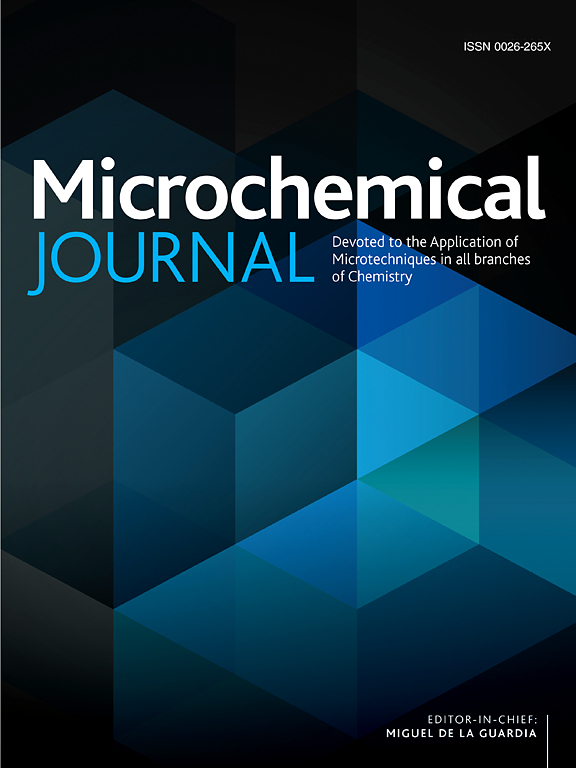A fluorescence and colorimetric dual-mode biosensor based on the catalytic activity of gold nanoparticles and magnetic upconversion nanoparticles for the detection of microRNAs
IF 4.9
2区 化学
Q1 CHEMISTRY, ANALYTICAL
引用次数: 0
Abstract
The overexpression of microRNA-21 (miRNA-21) is closely associated with gastric cancer (GC) and may be used as a biomarker to diagnose GC early. Here, a colorimetry and fluorescence dual-mode biosensor for the detection of miRNA-21 was developed from polydopamine-coated magnetic upconversion nanoparticles (Fe3O4@UCNP@PDA) and aptamer-modified gold nanoparticles (AuNP-apt). The strong adsorption of single-stranded DNA by PDA results in close proximity between the energy donors (UCNPs) and acceptors (AuNPs), resulting in luminescence quenching of the UCNPs. The miRNA-21 can hybridize with the apt-conjugated AuNPs, and the AuNPs move away from the UCNPs, which results in the luminescence recovery of the UCNPs and the catalytic activity of the AuNPs. After H2O2 and tetrapaminophenylethylene were added, the yellow solution turned green and gradually deepened with increasing miRNA-21 concentration. Under optimal conditions, the detection limits of miRNA-21 by fluorescence and colorimetry assays are 8.90 pM and 185 pM, respectively. In addition, the developed approach was utilized to measure miRNA-21 in serum samples, and the recovery rates ranged from 105.4-107.1% and 98.5–109.3%, respectively. The above results indicate great promise for the early diagnosis of GC because of its high sensitivity and selectivity.
一种基于金纳米粒子和磁性上转换纳米粒子催化活性的荧光和比色双模生物传感器,用于检测microrna
microRNA-21 (miRNA-21)的过表达与胃癌(GC)密切相关,可作为早期诊断胃癌的生物标志物。本文以聚多巴胺包被磁性上转换纳米粒子(Fe3O4@UCNP@PDA)和适配体修饰金纳米粒子(AuNP-apt)为材料,开发了一种用于检测miRNA-21的比色法和荧光双模生物传感器。PDA对单链DNA的强吸附导致能量供体(UCNPs)和受体(AuNPs)之间的距离很近,从而导致UCNPs的发光猝灭。miRNA-21可以与apt偶联的AuNPs杂交,使AuNPs远离UCNPs,从而使UCNPs的发光恢复和AuNPs的催化活性增强。加入H2O2和四氨基苯基乙烯后,随着miRNA-21浓度的增加,黄色溶液变绿并逐渐变深。在最佳条件下,荧光法和比色法对miRNA-21的检出限分别为8.90 pM和185 pM。此外,将该方法用于血清样品中miRNA-21的测定,回收率分别为105.4-107.1%和98.5-109.3%。以上结果表明气相色谱具有较高的灵敏度和选择性,在早期诊断方面具有很大的前景。
本文章由计算机程序翻译,如有差异,请以英文原文为准。
求助全文
约1分钟内获得全文
求助全文
来源期刊

Microchemical Journal
化学-分析化学
CiteScore
8.70
自引率
8.30%
发文量
1131
审稿时长
1.9 months
期刊介绍:
The Microchemical Journal is a peer reviewed journal devoted to all aspects and phases of analytical chemistry and chemical analysis. The Microchemical Journal publishes articles which are at the forefront of modern analytical chemistry and cover innovations in the techniques to the finest possible limits. This includes fundamental aspects, instrumentation, new developments, innovative and novel methods and applications including environmental and clinical field.
Traditional classical analytical methods such as spectrophotometry and titrimetry as well as established instrumentation methods such as flame and graphite furnace atomic absorption spectrometry, gas chromatography, and modified glassy or carbon electrode electrochemical methods will be considered, provided they show significant improvements and novelty compared to the established methods.
 求助内容:
求助内容: 应助结果提醒方式:
应助结果提醒方式:


